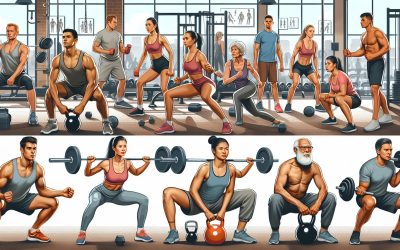Blast Fat, Boost Fitness: Unleash the Power of HIIT Training
HIIT Myths Busted: What You Need to Know for Success
Results with High-Intensity Interval Training: Are you looking for a workout routine that maximizes efficiency and results?
High-Intensity Interval Training (HIIT) might be just what you need. HIIT is a popular training method that combines short bursts of intense exercise with periods of rest or low-intensity exercise.
The goal of HIIT is to get your heart rate up and keep it there, allowing you to burn more calories in less time.
One of the biggest advantages of HIIT is its efficiency. With HIIT, you can get a full-body workout in as little as 15-30 minutes. This makes it a great option for people who are short on time but still want to see results.
HIIT has also been shown to be effective at burning fat and improving cardiovascular fitness. If you’re looking to lose weight or improve your overall health, HIIT may be a great option for you.
Understanding High-Intensity Interval Training
Personalize Your HIIT Routine for Optimal Success
If you’re looking for a way to maximize your workout efficiency and results, High-Intensity Interval Training (HIIT) is a great option to consider. HIIT is a form of exercise that involves short bursts of intense activity followed by periods of rest or low-intensity exercise.
The idea behind HIIT is to push your body to its limits during high-intensity intervals, which can last anywhere from a few seconds to a few minutes, and then give it a chance to recover during periods of rest or low-intensity exercise.
This cycle is repeated several times during a typical HIIT workout session.
One of the main benefits of HIIT is that it can help you burn more calories in less time compared to traditional steady-state cardio exercises.
This is because HIIT workouts are designed to be short and intense, which means you can get a lot done in a shorter amount of time.
Another benefit of HIIT is that it can help improve your cardiovascular health by increasing your heart rate during high-intensity intervals. This can lead to a stronger heart and improved endurance over time.
There are several types of HIIT workouts, including Sprint Interval Training (SIT) and Aerobic HIIT. SIT involves short, all-out sprints followed by longer periods of rest, while Aerobic HIIT involves longer periods of high-intensity exercise, such as jumping jacks or burpees, followed by shorter periods of rest.
The work-to-rest ratio is also a crucial factor to consider when doing HIIT. This refers to the amount of time you spend working versus resting during each interval.
A common work-to-rest ratio for HIIT is 2:1, which means you work for twice as long as you rest. However, this can vary depending on your fitness level and goals.
Overall, HIIT is a great option for anyone looking to get a challenging and effective workout in a shorter amount of time.
Just be sure to consult with a healthcare professional before starting any new exercise program, especially if you have any underlying health conditions or injuries.
Benefits of High-Intensity Interval Training
If you’re looking to improve your fitness level and health outcomes, High-Intensity Interval Training (HIIT) may be just what you need. HIIT is a form of exercise that involves short bursts of vigorous activity followed by periods of rest or low-intensity exercise.
Here are some of the benefits of incorporating HIIT into your fitness routine:
Improved Cardiovascular Health
HIIT has been shown to improve cardiorespiratory fitness, which is a measure of how well your body can transport and use oxygen during exercise. This can lead to a reduced risk of heart disease and improved overall health.
Lower Blood Pressure
HIIT may also help to lower blood pressure, which is a risk factor for heart disease. One study found that just 8 weeks of HIIT resulted in a significant reduction in systolic blood pressure (the top number) in adults with high blood pressure.
Increased Insulin Sensitivity
HIIT can also improve metabolic health by increasing insulin sensitivity. This means that your body is better able to use insulin to regulate blood sugar levels, which can reduce the risk of type 2 diabetes.
More Efficient Workouts
One of the biggest benefits of HIIT is that it allows you to get a great workout in a shorter amount of time.
Because HIIT involves short bursts of high-intensity exercise, you can burn more calories and increase your metabolic rate in less time than traditional steady-state cardio.
Physiological Adaptation
HIIT can also lead to physiological adaptations that improve your overall fitness level. For example, it can increase your aerobic capacity, which is a measure of how well your body can use oxygen during exercise. This can lead to improved endurance and performance in other types of exercise.
Variety in Your Workout Routine
HIIT can also add some variety to your workout routine. Because there are so many different exercises and formats you can use for HIIT, you can keep your workouts interesting and challenging.
Overall, incorporating HIIT into your fitness routine can lead to a wide range of health benefits, including improved cardiovascular health, lower blood pressure, and increased insulin sensitivity.
Plus, it’s a wonderful way to get a more efficient workout and add some variety to your routine.
HIIT and Chronic Diseases
If you have a chronic disease such as diabetes, hypertension, cardiovascular disease, metabolic disease, stroke, or cancer, incorporating high-intensity interval training (HIIT) into your exercise routine may be beneficial.
HIIT involves short bursts of intense exercise followed by periods of rest or low-intensity exercise.
Studies have shown that HIIT can improve cardiovascular health, insulin sensitivity, and glucose control in individuals with type 2 diabetes mellitus. It may also reduce blood pressure and improve lipid profiles in individuals with hypertension.
In addition, HIIT has been shown to improve cardiorespiratory fitness and reduce CVD risk factors such as obesity, insulin resistance, and inflammation in individuals with coronary heart disease and coronary artery disease.
It may also improve exercise capacity and quality of life in individuals with chronic heart failure.
It is important to note that if you have a chronic disease, you should consult with your healthcare provider before starting any new exercise program, including HIIT. Your provider can help you determine if HIIT is appropriate for you and can provide guidance on how to safely incorporate it into your routine.
Overall, HIIT can be an efficient and effective way to improve health outcomes in individuals with chronic diseases.
HIIT for Different Age Groups
HIIT Unveiled: A Game-Changer for Time-Crunched Individuals
Results with High-Intensity Interval Training: High-Intensity Interval Training (HIIT) is a wonderful way to maximize efficiency and results in your workouts. HIIT can be beneficial for people of all ages, including older adults.
In fact, studies have shown that HIIT can be well-tolerated in older adults and may confer health benefits over moderate-intensity continuous training [1].
As you age, your body undergoes changes that can make it more difficult to maintain muscle mass and cardiovascular fitness.
However, incorporating HIIT into your exercise routine can help you combat these changes. HIIT can help you build and maintain muscle mass, improve cardiovascular fitness, and boost metabolism [2].
If you are an older adult, it is important to speak with your doctor before starting any new exercise program, including HIIT.
Your doctor can help you determine if HIIT is safe for you and provide guidance on how to modify exercises to meet your needs.
When starting HIIT, it is important to start slowly and gradually increase the intensity and duration of your workouts. You may also want to consider working with a personal trainer who has experience of working with older adults.
A personal trainer can help you develop a safe and effective HIIT program that meets your individual needs and goals.
In conclusion, HIIT can be a wonderful way for older adults to maximize efficiency and results in their workouts.
Speak with your doctor and consider working with a personal trainer to develop a safe and effective HIIT program.
With the right approach, HIIT can help you build and maintain muscle mass, improve cardiovascular fitness, and boost metabolism.
[1] High-Intensity Interval Training in Older Adults: a Scoping Review
[2] Maximize Gains with HIIT: A Stanford Lifestyle Guide
Incorporating HIIT into Lifestyle
If you want to incorporate HIIT into your lifestyle, there are a few things you can do to make it easier. First, choose a practical model that works for you. The 10-20-30 protocol and Tabata are two popular HIIT models that are easy to follow and can be done anywhere.
Time efficiency is another key factor to consider when incorporating HIIT into your lifestyle. HIIT workouts are typically shorter than traditional workouts, so they can be a wonderful way to save time. You can get a great workout in as little as 20-30 minutes.
When it comes to prevention and public health, HIIT has been shown to be effective in improving cardiovascular and metabolic health. It may also help prevent chronic diseases such as type 2 diabetes and obesity.
Incorporating HIIT into your lifestyle can also be a fantastic way to stay on top of the latest fitness trends. HIIT is one of the most popular fitness trends right now, and for good reason. It’s a wonderful way to get a full-body workout in a short amount of time.
Finally, when incorporating HIIT into your lifestyle, it’s important to make sure you’re doing it safely. Make sure to warm up properly before starting your workout and listen to your body. If you’re new to HIIT, start with shorter intervals and gradually increase the intensity as you get stronger.
Overall, incorporating HIIT into your lifestyle can be a fantastic way to improve your physical activity and fitness level. It’s a practical and time-efficient way to stay healthy and fit, and it’s a terrific way to stay on top of the latest fitness trends.
HIIT and Mental Health – Results with High-Intensity Interval Training
High-intensity interval Training (HIIT) is a wonderful way to improve your physical health, but did you know it can also have a positive impact on your mental health?
Research has shown that HIIT can help reduce symptoms of depression and improve overall mental health and cognition.
One study found that the benefits of HIIT for reducing depressive symptoms are comparable to moderate-intensity continuous training (MICT), which is typically done at an intensity of 50% to 70% heart rate continuously for 30 to 60 minutes.
Another study found that acute HIIT sessions can have small to moderate effects on executive function and affect, which are both important aspects of mental health.
If you’re looking to improve your mental health through exercise, HIIT may be a great option for you.
It’s important to note that HIIT is a safe and feasible form of exercise, but as with any exercise program, it’s important to consult with your doctor before starting.
In addition to reducing symptoms of depression, HIIT has also been shown to improve psychological well-being, psychological distress, and physical self-concept in adolescents.
Another meta-analysis found that HIIT can have beneficial effects on mental health in both healthy populations and those with physical illnesses.
Overall, HIIT can be a wonderful way to improve both your physical and mental health. Incorporating HIIT into your exercise routine can help you maximize efficiency and results while also improving your mental health.
The World Health Organization (WHO) recognizes the importance of physical activity in maintaining good health.
According to WHO, adults aged 18-64 should engage in at least 150 minutes of moderate-intensity aerobic physical activity throughout the week or at least 75 minutes of vigorous-intensity aerobic physical activity throughout the week or an equivalent combination of both.
High-intensity interval Training (HIIT) is a type of vigorous-intensity aerobic physical activity that has gained popularity in recent years due to its efficiency and effectiveness.
HIIT involves short bursts of intense exercise followed by periods of rest or lower-intensity exercise.
In a 2018 report, WHO acknowledged that HIIT can be an effective way to improve cardiorespiratory and metabolic health in adults.
However, WHO also emphasized the importance of considering individual fitness levels and health status when prescribing HIIT.
It is recommended that individuals consult with their healthcare provider before starting any new exercise program, including HIIT.
Additionally, HIIT should be gradually incorporated into a fitness routine and should be tailored to individual fitness levels and goals.
Overall, while HIIT can be a time-efficient and effective way to improve health and fitness, it is important to approach it with caution and to prioritize safety and individual needs.
HIIT and Exercise Training Models
Results with High-Intensity Interval Training: If you’re looking to maximize your workout efficiency and results, High-Intensity Interval Training (HIIT) may be the perfect solution for you.
HIIT is a type of exercise training that alternates between short periods of high-intensity exercise and recovery periods of lower-intensity exercise.
This training model has been shown to be highly effective in improving exercise capacity and metabolic health in both clinical and healthy populations.
HIIT is often compared to moderate-intensity continuous training (MICT), which is a type of aerobic exercise that involves sustained exercise at a moderate intensity.
While MICT is effective in improving cardiovascular health, HIIT has been shown to be more effective in improving both cardiovascular and metabolic health.
One of the benefits of HIIT is that it can be performed with a variety of exercises and equipment, making it a versatile and customizable workout option.
Some popular HIIT exercises include Tabata, which involves 20 seconds of high-intensity exercise followed by 10 seconds of rest for eight rounds, and burpees, which involve squatting, jumping, and push-ups in a continuous sequence.
HIIT can also be performed using equipment such as a cycle ergometer, which is a stationary bike that allows for varying levels of resistance and intensity.
With HIIT, you can adjust the intensity and duration of the exercise to your fitness level and goals, making it a great option for beginners and advanced athletes alike.
Overall, HIIT is a highly efficient and effective exercise training model that can help you achieve your fitness goals in less time than traditional exercise methods.
Incorporating HIIT into your workout routine can help you improve your exercise capacity, metabolic health, and overall fitness level.
Research on HIIT
High-Intensity Interval Training (HIIT) has become increasingly popular in recent years due to its potential to maximize workout efficiency and improve exercise capacity.
Numerous studies have investigated the effects of HIIT on various health outcomes, including mortality, all-cause mortality, and endothelial function.
One meta-analysis of randomized controlled trials found that HIIT was associated with a significant reduction in all-cause mortality compared to control groups.
Another study found that HIIT improved endothelial function, which is important for cardiovascular health.
In terms of exercise capacity, research has indicated that HIIT induces numerous physiological adaptations that improve maximal oxygen uptake, aerobic endurance, and anaerobic capacity in both clinical and healthy populations.
It is important to note that HIIT is not necessary for fat loss or any more effective than other means.
However, it is a time-efficient way to improve cardiovascular fitness and has been shown to be an effective alternative to moderate-intensity continuous training (MCT).
Overall, the research on HIIT suggests that it is a safe and effective way to improve exercise capacity and reduce all-cause mortality. Incorporating HIIT into your exercise routine may be a beneficial way to maximize efficiency and results.
HIIT for Fitness Professionals
Results with High-Intensity Interval Training: As a fitness professional, you are familiar with the concept of High-Intensity Interval Training (HIIT).
HIIT is a popular and effective workout technique that involves short bursts of intense exercise followed by brief periods of rest or lower-intensity activity.
This type of training has become increasingly popular in recent years due to its efficiency in burning calories, improving cardiovascular fitness, and building strength.
If you are a fitness professional, incorporating HIIT into your clients’ workouts can be a great way to maximize their efficiency and results.
HIIT can be customized to fit any fitness level and can be done with a variety of equipment, making it a versatile option for your clients.
When designing a HIIT workout for your clients, it is important to keep their fitness level in mind.
Start with shorter intervals and longer rest periods for beginners and gradually increase the intensity and duration as they progress. It is also important to mix up the exercises to keep the workout challenging and engaging.
Another benefit of HIIT is that it can be done in a shorter amount of time than traditional workouts. This is great for clients who have busy schedules and may not have time for longer workouts. A 20-30-minute HIIT workout can be just as effective as a longer workout, making it a time-efficient option for your clients.
Overall, incorporating HIIT into your clients’ workouts can be a terrific way to maximize their efficiency and results.
With its versatility and time efficiency, HIIT can be a fantastic addition to any fitness program.
Conclusion
In conclusion, High-Intensity Interval Training (HIIT) is a highly efficient and effective form of exercise that can produce noteworthy results in a shorter amount of time than traditional moderate-intensity continuous training.
HIIT has been shown to improve aerobic and anaerobic capacity, metabolic health, and overall fitness in both clinical and healthy populations.
One of the key benefits of HIIT is its ability to produce results with shorter workout times.
HIIT workouts typically range from 10-30 minutes, making it a great option for those with busy schedules or limited time for exercise.
Additionally, HIIT can be adapted to fit a variety of fitness levels and preferences, with options for bodyweight exercises, cardio machines, and resistance training.
While HIIT can be a highly effective form of exercise, it is important to approach it with caution and proper form.
Due to the high intensity of the workouts, it is important to gradually increase intensity and duration over time to avoid injury or overexertion.
Additionally, it is important to consult with a healthcare professional before beginning any new exercise program, especially if you have any underlying health conditions.
Overall, HIIT can be a great option for those looking to maximize their efficiency and results in a shorter amount of time.
With proper form and caution, HIIT can be a safe and effective form of exercise for a variety of fitness levels and goals.
Elizabeth Redd: I am a passionate advocate for Health and Healing, dedicated to empowering individuals to live their best lives.
As the founder and publisher of Health and Healing, I have established myself as a guiding force in the wellness industry.
I am committed to providing the latest research, holistic approaches, and inspiring stories to open new possibilities for your health and healing journey.
Learn more about Elizabeth and Join Us at Health and Healing. Also, check out My About Page.









0 Comments